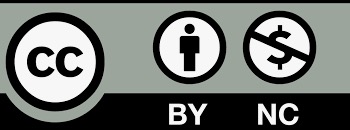Published
2025-03-30
Section
Research Articles
License
Copyright (c) 2025 Liying Li, Dr. Siegfried M. Erorita

This work is licensed under a Creative Commons Attribution-NonCommercial 4.0 International License.
The journal adopts the Attribution-NonCommercial 4.0 International (CC BY-NC 4.0), which means that anyone can reuse and redistribute the materials for non-commercial purposes as long as you follow the license terms and the original source is properly cited.
Author(s) shall retain the copyright of their work and grant the Journal/Publisher rights for the first publication with the work concurrently licensed since 2023 Vol.8 No.2.
Under this license, author(s) will allow third parties to download, reuse, reprint, modify, distribute and/or copy the content under the condition that the authors are given credit. No permission is required from the authors or the publisher.
This broad license intends to facilitate free access, as well as the unrestricted use of original works of all types. This ensures that the published work is freely and openly available in perpetuity.
By providing open access, the following benefits are brought about:
- Higher Visibility, Availability and Citations-free and unlimited accessibility of the publication over the internet without any restrictions increases citation of the article.
- Ease of search-publications are easily searchable in search engines and indexing databases.
- Rapid Publication – accepted papers are immediately published online.
- Available for free download immediately after publication at https://esp.as-pub.com/index.php/ESP

Copyright Statement
1.The authors certify that the submitted manuscripts are original works, do not infringe the rights of others, are free from academic misconduct and confidentiality issues, and that there are no disputes over the authorship scheme of the collaborative articles. In case of infringement, academic misconduct and confidentiality issues, as well as disputes over the authorship scheme, all responsibilities will be borne by the authors.
2. The author agrees to grant the Editorial Office of Environment and Social Psychology a licence to use the reproduction right, distribution right, information network dissemination right, performance right, translation right, and compilation right of the submitted manuscript, including the work as a whole, as well as the diagrams, tables, abstracts, and any other parts that can be extracted from the work and used in accordance with the characteristics of the journal. The Editorial Board of Environment and Social Psychology has the right to use and sub-licence the above mentioned works for wide dissemination in print, electronic and online versions, and, in accordance with the characteristics of the periodical, for the period of legal protection of the property right of the copyright in the work, and for the territorial scope of the work throughout the world.
3. The authors are entitled to the copyright of their works under the relevant laws of Singapore, provided that they do not exercise their rights in a manner prejudicial to the interests of the Journal.
About Licence
Environment and Social Psychology is an open access journal and all published work is available under the Creative Commons Licence, Authors shall retain copyright of their work and grant the journal/publisher the right of first publication, and their work shall be licensed under the Attribution-NonCommercial 4.0 International (CC BY-NC 4.0).
Under this licence, the author grants permission to third parties to download, reuse, reprint, modify, distribute and/or copy the content with attribution to the author. No permission from the author or publisher is required.
This broad licence is intended to facilitate free access to and unrestricted use of original works of all kinds. This ensures that published works remain free and accessible in perpetuity. Submitted manuscripts, once accepted, are immediately available to the public and permanently accessible free of charge on the journal’s official website (https://esp.as-pub.com/index.php/ESP). Allowing users to read, download, copy, print, search for or link to the full text of the article, or use it for other legal purposes. However, the use of the work must retain the author's signature, be limited to non-commercial purposes, and not be interpretative.
Click to download <Agreement on the Licence for the Use of Copyright on Environmental and Social Psychology>.
How to Cite
Psychological attribution of organizational change resistance in the context of intelligent wealth management transformation
Liying Li
College of Business Administration, University of the Cordilleras, Baguio City, 2600, Philippines
Dr. Siegfried M. Erorita
College of Accountancy, University of the Cordilleras, Baguio City, 2600, Philippines
DOI: https://doi.org/10.59429/esp.v10i3.3312
Keywords: digital transformation; psychological attribution; change resistance; intelligent wealth management; organizational culture
Abstract
This research investigates the psychological attribution tendencies that occur in resistance to organizational change, within the context of intelligent wealth management transformation. Through a mixed-methods strategy integrating quantitative surveys (n=389) and qualitative interviews (n=42), this study investigates in detail the complexities of interrelationships among individual psychological variables, the organizational environment, and manifestations of resistance. Path analysis by structural equation modeling showed significant associations of cognitive and emotional attribution patterns with technological self-efficacy (β = 0.684, p < 0.001) and perceived organizational support (β = 0.571, p < 0.001), respectively. Longitudinal analysis has shown that active resistance is significantly lowered within the implementation period and that organizational culture acts as an important mediator within the relations between psychological characteristics and resistance behaviors. The findings indicate that the nature of the resistance to digitization is determined by both individual psychological factors and institutional context. It further varies at different patterns on each organizational level and tenure group. The study contributes to both theoretical and managerial thinking by giving an in-depth look at essential psychological mechanisms that drive resistance to technological changes within financial institutions. The findings imply that successful digital transformation has to be holistically addressed, taking into consideration both the cognitive and emotional dimensions of change resistance, mediated by organizational culture. These will provide very important guidelines for financial institutions to implement the Intelligent Wealth Management System, adding to the general literature of organizational change management in the digital era.
References
[1]. 1.Abu-Shanab, E. (2011). Education level as a technology adoption moderator. In 2011 3rd International Conference on Computer Research and Development (Vol. 1, pp. 60-64). IEEE.
[2]. 2.Agarwal, R., & Karahanna, E. (2000). Time flies when you're having fun: Cognitive absorption and beliefs about information technology usage. MIS Quarterly, 24(4), 665-694.
[3]. 3.Ashford, S. J. (1988). Individual strategies for coping with stress during organizational transitions. Journal of Applied Behavioral Science, 24(1), 19-36.
[4]. 4.Baazeem, R. (2018). The role of religiosity in technology acceptance: The case of privacy in Saudi Arabia. In Psychological and behavioral examinations in cyber security (pp. 184-198). IGI Global.
[5]. 5.Bandura, A. (1997). Self-efficacy: The exercise of control. Freeman.
[6]. 6.Belanche, D., Casaló, L. V., & Flavián, C. (2012). Integrating trust and personal values into the technology acceptance model: The case of e-government services adoption. Cuadernos de Economía y Dirección de la Empresa, 15(4), 192-204.
[7]. 7.Chung, S., Lee, K. Y., & Kim, K. (2014). Job performance through digital transformation: The role of psychological ownership and resistance to change. Sustainability, 6(3), 1250-1268.
[8]. 8.Davis, F. D., Bagozzi, R. P., & Warshaw, P. R. (1989). User acceptance of computer technology: A comparison of two theoretical models. Management Science, 35(8), 982-1003.
[9]. 9.Diener, F., & Špaček, M. (2021). Digital transformation in banking: A managerial perspective on barriers to change. Sustainability, 13(4), 2032.
[10]. 10.Folkman, S., Lazarus, R. S., Gruen, R. J., & DeLongis, A. (1986). Appraisal, coping, health status, and psychological symptoms. Journal of Personality and Social Psychology, 50(3), 571-579.
[11]. 11.Hayes, J. (2018). The theory and practice of change management (5th ed.). Palgrave Macmillan.
[12]. 12.Hess, T., Matt, C., Benlian, A., & Wiesböck, F. (2016). Options for formulating a digital transformation strategy. MIS Quarterly Executive, 15(2), 123-139.
[13]. 13.Im, I., Kim, Y., & Han, H. (2008). The effects of perceived risk and technology type on users' acceptance of technologies. Information & Management, 45(1), 1-9.
[14]. 14.Judge, T. A., Thoresen, C. J., Pucik, V., & Welbourne, T. M. (1999). Managerial coping with organizational change: A dispositional perspective. Journal of Applied Psychology, 84(1), 107-122.
[15]. 15.Jung, D., Dorner, V., Weinhardt, C., & Pusmaz, H. (2018). Designing a robo-advisor for risk-averse, low-budget consumers. Electronic Markets, 28(3), 367-380.
[16]. 16.Kobasa, S. C. (1979). Stressful life events, personality, and health: An inquiry into hardiness. Journal of Personality and Social Psychology, 37(1), 1-11.
[17]. 17.Krasonikolakis, I., Tsarbopoulos, M., & Eng, T.-Y. (2020). Are incumbent banks bygones in the face of digital transformation. Journal of General Management, 46(1), 60-69.
[18]. 18.Lau, C. M., & Woodman, R. W. (1995). Understanding organizational change: A schematic perspective. Academy of Management Journal, 38(2), 537-554.
[19]. 19.Lee, M. (2009). Factors influencing the adoption of internet banking: An integration of TAM and TPB with perceived risk and perceived benefit. Electronic Commerce Research and Applications, 8(3), 130-141.
[20]. 20.Liu, D. Y., Chen, S. W., & Chou, T. C. (2011). Resource fit in digital transformation: Lessons learned from the CBC Bank global e-banking project. Management Decision, 49(10), 1728-1742.
[21]. 21.Oreg, S. (2006). Personality, context, and resistance to organizational change. European Journal of Work and Organizational Psychology, 15(1), 73-101.
[22]. 22.Park, I., Kim, D., Moon, J., Kim, S., Kang, Y., & Bae, S. (2022). Searching for new technology acceptance model under social context: Analyzing the determinants of acceptance of intelligent information technology in digital transformation and implications for the requisites of digital sustainability. Sustainability, 14(1), 579.
[23]. 23.Rousseau, D. M., & Tijoriwala, S. A. (1999). What's a good reason to change? Motivated reasoning and social accounts in promoting organizational change. Journal of Applied Psychology, 84(4), 514-528.
[24]. 24.Shaban-Nejad, A., Michalowski, M., & Buckeridge, D. L. (2018). Health intelligence: How artificial intelligence transforms population and personalized health. NPJ Digital Medicine, 1(1), 1-2.
[25]. 25.Westerman, G., Bonnet, D., & McAfee, A. (2014). The nine elements of digital transformation. MIT Sloan Management Review, 55(3), 1-6.







